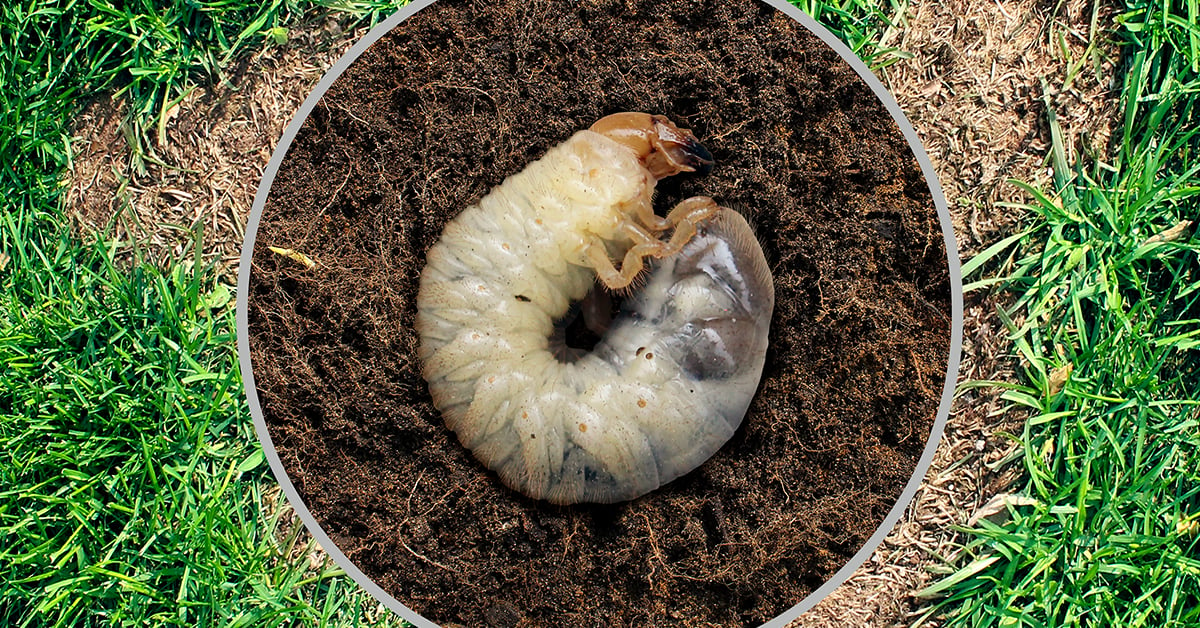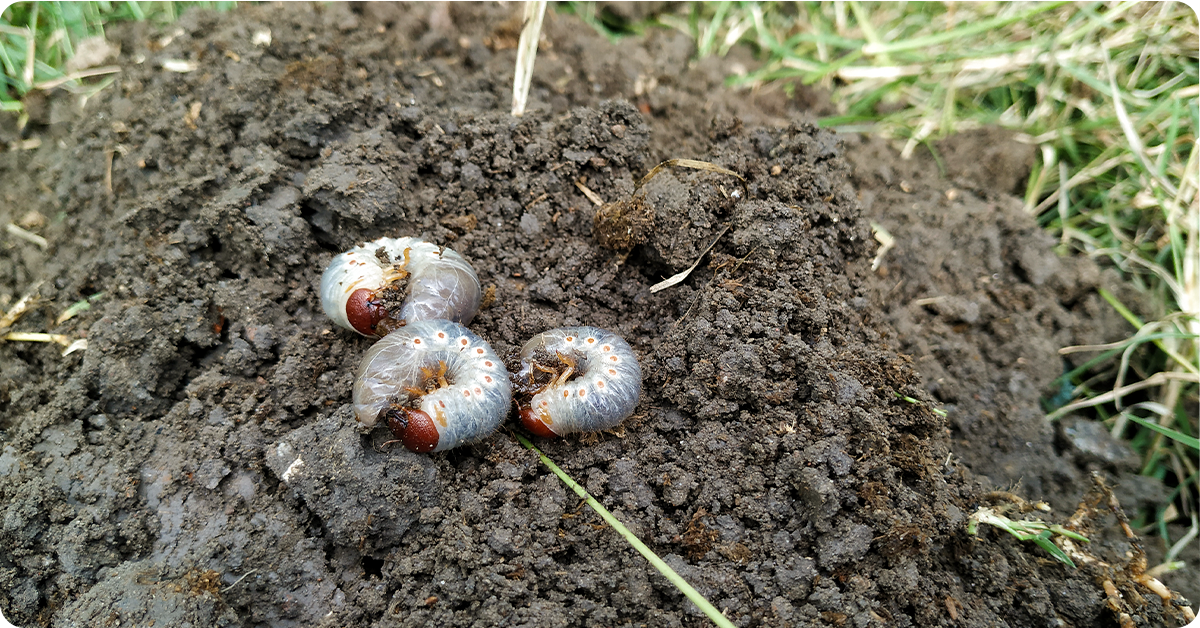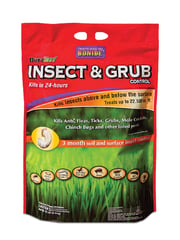
A healthy lawn should complement the home and yard you’ve worked so hard to shape and cultivate. Maintaining a lush, green lawn takes more than consistent watering and weekly trimming.
Achieving the most beautiful lawn on the block is well worth it, however, it can also attract more than envious neighbors. Insects and other pests may also take notice and have at your lawn’s natural green sheen, moving it a bit more to the yellow side. Dry or dead patches in your grass could be caused by several things, from inadequate watering to fungus, to other types of insects such as grub worms.
Grub worms are the small white larval life stage of various beetle types that feed on grass roots and are a common lawn issue in the Intermountain West. They are voracious eaters that feed throughout the summer and even into the fall, but they can be stopped.
Here are common signs and how to treat and prevent grub worms in the future.
What Are Grub Worms?
The creepy little critters that may possibly be feasting on your lawn are called grub worms. They are the larvae of insects that hatch from the eggs of Billbugs, June beetles or other insects that eat the roots of grass, killing the lawn in the process.
Billbug larvae are legless with cream-colored bodies. Their appearance has been described as a, “grain of rice with a brown head.” White grubs on the other hand are a creamy-white color with a rusty orange head and six legs at the front of their body. White grubs are C-shaped and their bodies appear slick and shiny.
Billbugs begin their lifecycle with the overwintering adult Billbugs laying their eggs in April and early May (earlier in Southern Utah). Soon after hatching the Billbug larvae begin to eat the crown of the grass plant, eventually working their way into the soil and begin attacking the roots of your lawn. Turfgrass damage from Billbug will become visible by late June to the first of July, and earlier in Southern Utah.

A white grub, which is the larvae of the June beetle, is a very destructive turfgrass pest in Utah and all through the Intermountain West. June beetles require three years to complete one generation or lifecycle. Adult June beetles start emerging from turfgrass in May and June, and in their first summer, mated females will deposit eggs in turfgrass. Eggs hatch into small white grubs that feed on young turfgrass roots until the temperature cools. These small grubs are in the overwintering stage until the next spring when they become active again.
During the second summer, grubs continue to grow while feeding on larger turfgrass roots until they are almost fully developed. The large grubs then go into another overwintering stage. During the third summer, the grub develops into a pupa in the soil and then emerges as an adult June beetle in May and June.
3 Signs of Grub Worm Damage to Lawns
If your lawn begins to show signs of damage, it’s important to diagnose and treat the affected area as soon as possible. Here are 3 signs of possible grub damage to lawns:
1. Spotty Dry Patches
Oddly shaped, splotchy dry areas in the lawn could be caused by a number of things in addition to grub damage, such as inadequate or inconsistent watering, fungus or compacted soil. If grubs are suspected, a tug test is recommended. To conduct a tug test, pull on the stems of the grass in the damaged area of your lawn. If the stems come off easily and break off at the soil surface, examine the bottom ends of the stems and see if a fine, powdery, almost sawdust-like material is observed. This white powdery material is called frass, which is what a Billbug grub leaves behind.
To verify that you indeed have a Billbug problem, cut a piece of lawn about 3 inches deep where the damaged lawn meets the healthy areas. Carefully break apart the sample and inspect it thoroughly. It is here that you will likely find active Billbug grubs and if so, immediate action is necessary.
In order to diagnose lawn damage caused by white grubs, take hold of a section of the dead or severely damaged lawn and pull. The sod will be quite loose, the roots having been severed by the grub and the grass can be pulled up like a carpet, revealing the C-shaped white grubs underneath.
2. Stressed Lawn Turf
Wilted, discolored, or stressed turf that does not respond to irrigation may also be a sign that your lawn is being damaged by grub worms. To be sure the cause is not inadequate water, turn on the sprinklers in the area of the lawn that looks stressed. Make sure there is not a partially clogged sprinkler nozzle or a sprinkler that is not adequately covering the affected area. If you find this to be the case, make the necessary adjustments to the sprinkler system to solve the problem. An adequate amount of water is ½” of water per watering. A tuna can is an easy way to catch and measure the amount during a sprinkler cycle. See our Lawn Watering Guide for more details and lawn watering tips.
3. Severe Lawn Damage
Severe lawn damage in your lawn can be caused by skunks, raccoons or other animals trying to dig up lawn grubs for their next meal.
How to Control Grub Worms
Have pesky grub worms taken a liking to your lawn?
Oftentimes the problem isn’t known until obvious lawn damage has already been done. There are ways to stop grub worms from causing additional damage. However, preventive measures are the most effective for the overall health of your lawn.

Prevent Grub Worms
With prevention being the most important part of keeping pests away from destroying your lawn, keep in mind that insects and larvae always attack the weakest lawns. Strengthening your lawn’s overall health is the best defense against infestations.
If your lawn (or your neighbor’s) has had grub problems in the past or you want to provide an additional measure of protection from grub damage, apply Bonide Insect & Grub Control. Bonide Insect & Grub Control's dual-action formula helps prevent grubs in two ways.
First, one ingredient can kill overwintering adult Billbugs before their egg-laying. Second, another of its ingredients is taken up by the grasses root system and stays in the grass’s system, providing protection for up to 3 months. When a newly hatched or overwintering grub begins to feed, it ingests the insecticide and dies. In the Intermountain West, treat your lawn with Bonide Insect & Grub Control from late April to the end of May to target adult Billbugs that have overwintered. Apply a second application in late May or early June. These two applications will provide complete insecticide protection from Billbug larvae. Utah residents in Washington County should start this process 30-45 days earlier.
If the problem continues, a third application may be necessary in August. Apply evenly over the lawn and water while following the directions on the bag.
Kill Existing Grub Worms
Grub worms are surprisingly common and can cause significant damage to your lawn in a short period, especially during the hottest months of summer.
If you have seen grub worms or unmistakable signs of them, it’s time to treat them. First, rake out the dead grass and apply an insecticide as directed. Don’t forget to treat a few feet into the green grass where the grubs are most likely feeding on the live grass.
The best control method is to treat with one of the following insecticides:
 |
Bonide Insect & Grub Control is a preventative product that helps disrupt the lifecycle of existing grub and insect problems. Bonide will kill adult Billbugs, ants, crickets, chinch bugs, cutworms, earwigs, fleas, roaches, sod webworms, ticks and more while also providing a 3-month surface and soil protection from further insect outbreaks. |
 |
24-Hour Grub Killer Plus from Bio-Advanced is best for severe infestations and will kill grubs and adult Billbugs within 24 hours. Acting as a 9-1-1 approach, Bio-Advanced’s formula kills on contact while also protecting from other insects such as armyworms, ants, ticks, chinch bugs, crickets, earwigs and more. |
On all insecticides, be sure to read and follow the directions on the label.
Turfgrasses and Lawn Management
Maintaining a healthy lawn is one of the best defenses against grub worms. The main challenge of turfgrass management is striking a balance between the nutrient requirements of the turf and maintaining an environment that is suitable for organisms that help with overall lawn health. Sound cultural practices include:
Select plant endophyte-enhanced turfgrasses. Many cultivars of perennial ryegrass, tall turf-type fescue and creeping red fescue provide resistance to Billbug adults and larvae. Some bluegrass varieties are also not as attractive to Billbugs and June beetles.
Maintain healthy lawn care methods such as proper mowing height, fertilization, irrigation, thatch management and cultivation to promote healthy, vigorous turf.
Healthier turf is capable of tolerating or quickly recovering from insect feeding and serves as the foundation of Integrated Pest Management (IPM). IPM is an all-inclusive approach to pest control that uses a combination of methods to reduce the number of pests to tolerable levels while maintaining a quality environment.
If your lawn has taken a major hit and larger areas are affected, you may need to re-seed or consider laying new sod for your lawn to recover fully.
Let Us Help
Our associates are as passionate about lawn care as you are. Feel free to stop by your local IFA Country Store and we'll be happy to answer any questions or help solve any lawn problem, grub-related or not.
Information for this article was provided by Aaron Jaussi, Branch Manager, Provo IFA Country Store; Nick Loveland, Certified Arborist, Assistant Manager, Ogden IFA Country Store; Ken Holt, Lawn & Garden Category Manager, IFA Country Store; and USU Extension.













